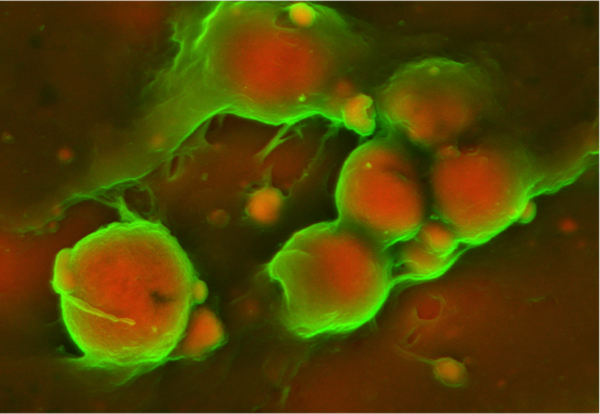
Scanning electron microscopy view of very small extracellular vesicles (~100 nanometers) merging to form a microcalcification. Image: Elena Aikawa Group
Using recently developed super-resolution microscopic techniques and a bioengineered model designed to mimic the connective tissue found in atherosclerotic plaques, researchers have been able to watch the formation of cardiovascular microcalcifications in real time, providing key insights into blockages that can lead to heart failure.
A team from Harvard Medical School and Brigham and Women’s Hospital used high-resolution imaging techniques and a three-dimensional model of calcified plaques to trace the steps that lead from tiny buildups of calcium to plaque ruptures and heart failure. Coronary calcium scores can predict cardiovascular events in patients, but microcalcifications in the coronary arteries can be so small (~5 micrometers) that traditional imaging techniques cannot detect them.
The research team, led by Elena Aikawa, HMS associate professor of medicine at Brigham and Women’s, and Joshua Hutcheson, HMS research fellow in medicine at Brigham and Women’s, pinpointed extracellular vesicles that led to the formation of microcalcifications, and observed the microcalcifications grow into stable, larger structures or, at vulnerable sites, cause plaque destabilization and rupture—a major cause of heart attacks. The results of the study are published in Nature Materials.
“We can now use this system to visualize what is happening and explore how to intervene in this process,” said Aikawa, who is also director of the Vascular Biology Program at Brigham and Women’s Center for Interdisciplinary Cardiovascular Sciences. “With the knowledge that we’ve gained here, we can now pick out the key extracellular vesicles, and find ways to target them before microcalcifications take shape.”
The structured illumination and other high-resolution microscopy techniques used in this research cannot currently be used in patients, but the researchers hope that innovations in imaging will help move this technology forward, and that future studies of the proteins involved in plaque formation will help identify points of therapeutic intervention.
Adapted from a Brigham and Women’s news release.


